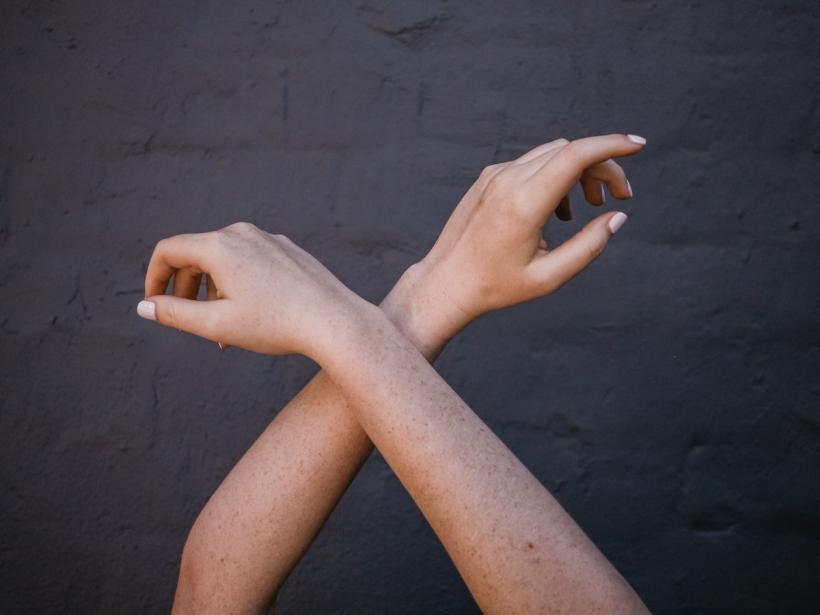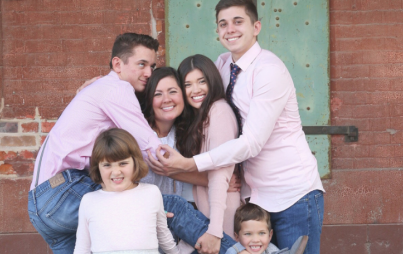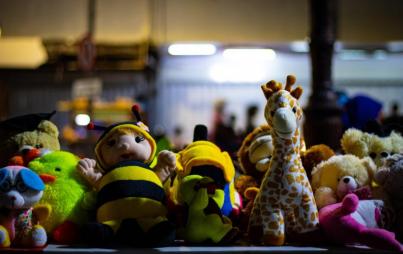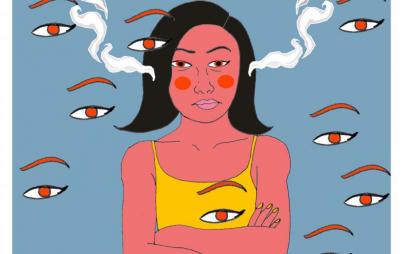
Photo by Nicole Honeywill on Unsplash
The second time someone held me down on a bed with force, I was 22, and my body sank gloriously with release. His hand held my neck softly at first and then, after eye contact and my head nodding desperately in approval and for more, harder. I remember making a connection, in that very second, of all the ways pain had entered my body during what we broadly define as sex, or sex-like, or sex-adjacent. I remembered the cramp in my wrist when I’d ride my fingers alone; the high I got after one of my college boyfriends bit my inner thigh so hard it left bruises; the agony of anticipation. I also thought about the pain from the things that aren’t sex — like the weight of my mom’s boyfriend on top of my small pre-teen body. I was scared of this mix.
The experiences I enjoyed were tainted with the one that made me terrified for my life.
As a feminist, it gave me pause to be so turned on by being submissive. But I was very turned on, and after college, I only sought more and more extreme versions of domination — restraints, slapping, choking, degradation, and most recently, a rope bondage class in a small DIY community space in Minneapolis that my partner L and I attended, with nervous anticipation.
When I looked around the room at the people in the class, I wondered about their stories. Mostly, there were couples, but a few solo men were in the circle with us as well. It was an incredibly diverse room — not majority white, not majority cisgender, not majority straight. There were bodies of all shapes and sizes. Ages ranged from an eager young 18-year-old woman who thanked the organizers for not making the event 21+, to a submissive-identified man in bicycle shorts and a blue tee-shirt who had to have been in his late 60s. What brought them to pain, I wondered, what brought them to settle into the comfort of “deviant” belonging?
It took me a bit to understand my own desire, not only as a queer person, but as a submissive.
This term was something I had to learn, years ago now, from the dark corners of the Internet, various pockets of queer culture, and also from pro-kink scholar Gayle Rubin who commented on the social construction of “deviant” sex acts: “Most of the discourses on sex, be they religious, psychiatric, popular, or political, delimit a very small portion of human sexual capacity as sanctifiable, safe, healthy, mature, legal, or politically correct. The ‘line’ distinguishes these from all other erotic behaviours, which are understood to be the work of the devil, dangerous, psychopathological, infantile, or politically reprehensible.”
When I learned the basics, I became red-cheeked with the realization that this was a world I wanted to be a part of. I would later eagerly learn more about BDSM, an acronym that encompasses bondage/discipline, dominance/submission, sadism/masochism, a similar umbrella to the term “kinky” — all of it describing sexual desire beyond the realm of vanilla sex. But I had concerns, because of mainstream narratives of kink as pathological, that perhaps I was just sick from my childhood assault. And I worried, because of particular versions of feminism, that maybe I was just a dupe of the patriarchy after all. Thankfully, none of those stories were right for me. I felt no recognition in shame or victimhood.
You Might Also Like: BDSM: Top Or Bottom? A Feminist Can Be Either
Instead, I found the great delight of empathy in sex-positive feminism (espoused by Rubin and others) that brings nuance to BDSM practices, assuring me that I can still be anti-patriarchy and want to be smacked around, and that regardless of my trauma, I deserve consensual pleasure wherever I can find it. As writer adrienne maree brown notes in her book Pleasure Activism: The Politics of Feeling Good, “Pleasure is not one of the spoils of capitalism. It is what our bodies, our human systems, are structured for; it is the aliveness and awakening, the gratitude and humility, the joy and celebration of being miraculous.”
The evening of the rope class, everyone in that concrete space had nestled their way into the identity of kinky.
There is power, almost always, in owning what has been labeled other, in proclaiming that you are not the norm and maybe that you’re okay with that.
When it comes to anything related to sex, though, there is a threshold for the public-ness of it. But there, (at the event that had a private sign-up link on FetLife, lest anyone notice this behavior on your Facebook), we were dipping our toe in the water of proclamation.
If you were in that room, we know your secret. But in that room, the secret is glorious.
Before we began learning our first knot, the person leading the session asked us to introduce ourselves — our names, our pronouns, why were there. I was delighted, mostly by the mix of timidness and excitement we heard in those disparate voices. I relished in that magic circle, the attention to gender, and the realization that we were all relative newbies.
The woman leading the session was fat, white, with blue hair, and described herself as a switch. She wore a t-shirt and what looked like swim trunks. She was charming and funny and began by emphasizing the importance of consent.
“Check-in, check-in, and then check-in again,” she urged us.
Then we began by learning a basic double column tie for our wrists. She came around the circle to observe and assist in our progress.
When L tied my wrists, and I tried to yank them apart, I felt the thrill of being safely trapped. A smile born of something primal erupted on my face. “
You like that?” he smiled back and grabbed my face with this hand. I nodded delightfully. Suddenly L was aware there were people all around, and he removed his hand.
We were navigating where the lines are between learning and enjoying, and it turns out they are very blurry.
The next knot was a chest harness that I was even more excited about, partly because I was more nervous about it. I’d had my wrists restrained before with various scarves and ties, but I hadn’t been tied up on my torso. Given that my most traumatic experience of sexual violence involved weight on my chest, and that I have ever since battled a mild case of claustrophobia, I was uncertain how my body would react. But this, for so many of us, is the point: what if we can take the sensations of fear and turn them into trust? I looked at my kind, loving partner with whom I have built over five years of hard-earned trust, and I felt so relaxed as he began to constrict my body. As queer femme dominatrix Daemonum X astutely notes, “In receiving consensual pain, it is essential to trust and be trusted, which is perhaps the most intimate of all.”
I felt the rope scratch my chest, shoulders, neck, and back, turning when he said to turn and adjusting my arms as needed. As exciting and sexy as this was, it was in equal parts silly and clumsy. Everyone else in our circle was struggling similarly with which way to turn and where to put their arms.
“Subs, never look down while your Dom is tying, or the rope will fly in your face,” our guide kept reminding us. “And it really hurts. More than you think it will.”
But inevitably I, and a few other subs, curiously glanced down to see our partner’s handiwork and were slapped in the face with the rope as it snapped from top to bottom.
“Ow!” I joined the chorus of pain.
L and I giggled, and he apologized as the pain dissipated, then continued working in earnest to get the loops right. I felt more and more confined, and when I let myself be present with it, I started to feel light the way I had felt in other bondage-like and masochistic moments. I was warm and cool at the same time. I was overcome with tingles that emerged on my skin. I closed my eyes, and my breath changed — my inhales and exhales deepened. L noticed.
“Good?” he asked.
My eyes were still closed; my head was fluttery, “Really good.” I nodded.
There is, of course, a vulnerability in this kind of release, and especially in this public place.
And yes, there is something sexual about this kind of bondage, but also there is something profoundly innocent and tremendously playful about our collective attempts at rope restraint. More importantly, there is something liberating about being with others when your desire has been, and continues to be in most realms, considered “wrong.” There is something that pulls so many of the marginalized into realms of fantasy — it is precisely what we need to imagine and create new worlds.
In her memoir, former sex-worker, AIDS activist, economic justice organizer, and all around brilliant femme, Amber Hollibaugh, explains that she wants “to be a warrior against shame of the erotic and for the right to taste and smell passion’s will.”
After rope class, I returned to her book, which I have read and re-read since I first discovered it in 2012, and looked up the passage. I felt, in rope class that afternoon, a bit of that warrior energy. I vibrated with shared defiance.
Hollibaugh ends that passage with this: “To create a movement willing to live the politics of sexual danger in order to create a culture of human hope. This is my dream today. This is my dangerous desire.”
When I return to the rope, I remember this.
Sinking into risk, I feel safe to explore possibility.
And in that possibility exists a vision of the future where pleasure is more central to our sexual lives than fear, and a world where power is something to which we all have access.








